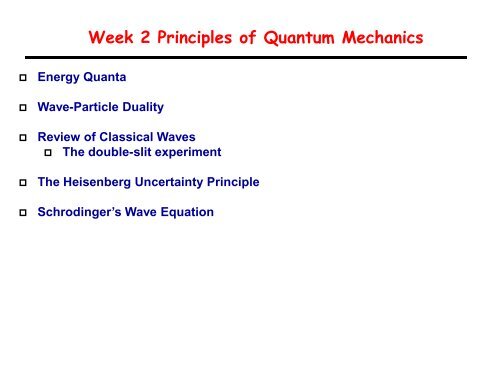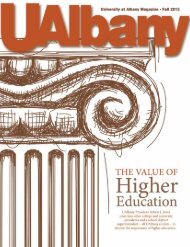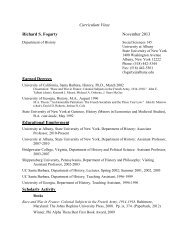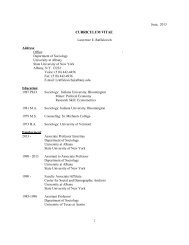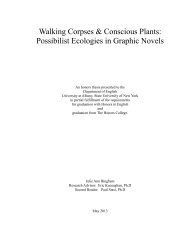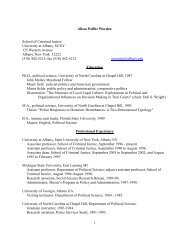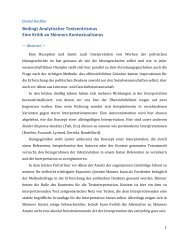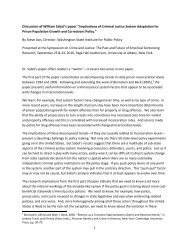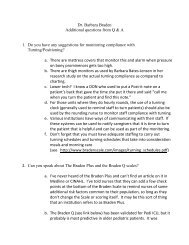Review of Classical Wave
Review of Classical Wave
Review of Classical Wave
You also want an ePaper? Increase the reach of your titles
YUMPU automatically turns print PDFs into web optimized ePapers that Google loves.
Week 2 Principles <strong>of</strong> Quantum Mechanics<br />
<br />
<br />
<br />
<br />
<br />
Energy Quanta<br />
<strong>Wave</strong>-Particle Duality<br />
<strong>Review</strong> <strong>of</strong> <strong>Classical</strong> <strong>Wave</strong>s<br />
The double-slit experiment<br />
The Heisenberg Uncertainty Principle<br />
Schrodinger’s <strong>Wave</strong> Equation
Planck’s Energy Quanta: Photoelectric Effects<br />
• The photoelectric effect shows the discrete nature <strong>of</strong> the photon and<br />
demonstrates the particle-like behavior <strong>of</strong> the photon .<br />
• Einstein explained the photoelectric effect by postulating that, in a<br />
photon, the energy was proportional to the frequency (1905).
Compton Effect<br />
• In this experiment, an x-ray beam is incident on a solid. A portion <strong>of</strong> the<br />
beam was deflected and the frequency <strong>of</strong> the deflected wave was shifted<br />
compared to the incident wave. The Compton effect, was explained by<br />
proposing that photons carry momentum.<br />
• If a photon collides with an<br />
electron, the wavelength and<br />
trajectory <strong>of</strong> the photon is<br />
observed to change. The<br />
wavelength shift <strong>of</strong> light after<br />
collision with an electron is<br />
consistent with a transfer <strong>of</strong><br />
momentum from a photon to<br />
the electron. The loss <strong>of</strong><br />
photon energy is reflected in a<br />
red shift <strong>of</strong> its frequency.
De Broglie’s <strong>Wave</strong>-Particle Duality Principles<br />
• In 1924. de Broglie postulated the existence <strong>of</strong> matter waves. He suggested<br />
that since waves exhibit particle-like behavior, then particles should also be<br />
expected to show wave-like properties.<br />
• The hypothesis <strong>of</strong> de Broglie was the existence <strong>of</strong> a wave-particle duality<br />
principle. The momentum <strong>of</strong> a photon is given by<br />
• Then, de Broglie hypothesized that the wavelength <strong>of</strong> a particle can be<br />
expressed as (de Broglie wavelength <strong>of</strong> the matter wave).
Davisson-Germer Experiment
Electron Diffraction through Double Slits<br />
• <strong>Classical</strong>ly, we would predict that electrons passing through slits in a screen<br />
should continue in straight lines, forming an exact image <strong>of</strong> the slits on the rear<br />
screen. In practice, however, a series <strong>of</strong> lines is formed on the rear screen,<br />
suggesting that the electrons have been somehow deflected by the slits.
<strong>Review</strong> <strong>of</strong> <strong>Classical</strong> <strong>Wave</strong><br />
• A wave is a periodic oscillation. It is convenient to describe waves using<br />
complex numbers. For example consider the function<br />
where x is position. This function can be plotted on the complex plane as<br />
a function <strong>of</strong> position, x. The phase <strong>of</strong> the function is the angle on the<br />
complex plane.
<strong>Review</strong> <strong>of</strong> <strong>Classical</strong> <strong>Wave</strong><br />
• The wavelength is defined as the distance between spatial repetitions <strong>of</strong><br />
the oscillation. This corresponds to a phase change <strong>of</strong><br />
• This wave is independent <strong>of</strong> time, and is known as a standing wave.<br />
• We could define a function whose phase varies with time:<br />
• We define the period, T, as the time between repetitions <strong>of</strong> the oscillation
<strong>Review</strong> <strong>of</strong> <strong>Classical</strong> <strong>Wave</strong><br />
• We can combine time and spatial phase oscillations to make a traveling<br />
wave.<br />
• The intensity <strong>of</strong> this wave is uniform everywhere it is known as a<br />
plane wave.<br />
• A plane wave has at least four dimensions (real amplitude, imaginary<br />
amplitude, x, and t), so we plot planes <strong>of</strong> a given phase. These plane waves<br />
move through space at the phase velocity <strong>of</strong> the wave
The Double Slit Experiment<br />
• Far from the double slit, the electrons from each slit can be described by<br />
plane waves, where s is the separation between the slits and L is the<br />
distance to the viewing screen. When the planes <strong>of</strong> constant phase collide,<br />
a bright line corresponding to a high intensity <strong>of</strong> electrons is observed.
• At the viewing screen we have
The Double Slit Experiment<br />
• At the screen, constructive interference between the plane waves from<br />
each slit yields a regular array <strong>of</strong> bright lines, corresponding to a high<br />
intensity <strong>of</strong> electrons. In between each pair <strong>of</strong> bright lines, is a dark band<br />
where the plane waves interfere destructively, i.e. the waves are out <strong>of</strong><br />
phase with one another.<br />
• The spacing between the bright lines at the viewing screen is<br />
• It is notable that the fringe pattern is independent <strong>of</strong> intensity. Thus, the<br />
interference effect should be observed even if just a single electron is<br />
fired at the slits at a time.<br />
• The only conclusion is that the electron – which we are used to thinking<br />
<strong>of</strong> as a particle - also has wave properties.
• The cumulative electron distribution after passage through a double slit.<br />
Just a single electron is present in the apparatus at any time.<br />
A. Tanamura et al., Am. J. Phys.<br />
57, 117 (1989).
The Electromagnetic Spectrum
Heisenberg’s Uncertainty Principle<br />
• Heisenberg’s uncertainty principle, given in 1927, applies primarily to very<br />
small particles, and states that we cannot describe with absolute accuracy<br />
the behavior <strong>of</strong> these subatomic particles.<br />
• The uncertainty principle describe a fundamental relationship between<br />
conjugate variables, including position and momentum and also<br />
energy and time.<br />
• The first statement <strong>of</strong> the uncertainty principle is that it is impossible to<br />
simultaneously describe with absolute accuracy the position and<br />
momentum <strong>of</strong> a particle.<br />
• The second statement <strong>of</strong> the uncertainty principle is that it is impossible to<br />
simultaneously describe with absolute accuracy the energy <strong>of</strong> a particle<br />
and the instant <strong>of</strong> time the particle has this energy.
Heisenberg’s Uncertainty Principle<br />
• The uncertainty principle is not very relevant to everyday objects
Schrodinger’s <strong>Wave</strong> Equation<br />
• The various experimental results involving electromagnetic waves and<br />
particles, which could not be explained by classical laws <strong>of</strong> physics, showed<br />
that a revised formulation <strong>of</strong> mechanics was required.<br />
• Erwin Schrodinger (1926), provided a formulation, called wave mechanics,<br />
which incorporated the principles <strong>of</strong> quanta introduced by Planck, and the<br />
wave-particle duality principle introduced by de Broglie.<br />
• Based on the wave-particle duality principle. we will describe the motion <strong>of</strong><br />
electrons in a solid or nanostructure by wave theory. This wave theory is<br />
described by Schrodinger's wave equation.


